Are you a data scientist or analyst looking for a good laptop? If so, choosing the right laptop might prove to be a tedious task indeed – you must look for the right elements in the device. (It’s not just about the price, manufacturer, etc.!)
The seemingly perfect laptop may have flaws you shouldn’t overlook, or it might not be within your budget. So, no, you can’t buy just any laptop. Absolutely not! Research is much easier nowadays so do your research! That’s what we did!
To help you on your journey, we’ve carefully crafted this list featuring our best picks. So look no further (at least not until you’ve finished here) and start reading!
Table of Contents
Best Laptops for Data Science and Data Analysis
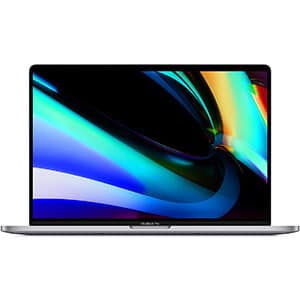
1. Apple MacBook Pro 16″
- Display: 16” Retina Display
- CPU: Intel Core i7-9750H
- GPU: AMD Radeon Pro 5300M
- RAM: 16 GB
- Storage: 512GB SSD
This novel creation by Apple is amazing. It is by far, one of the best laptops created by this company as it outshines its predecessors tenfold.
Let’s start with the good things: the keyboard has been updated to a much more reliable and usable form so we can all breathe a sigh of relief. Customers had many complaints about the MacBook’s flimsy keyboards. Also, the keys previously associated with the Touch Bar, which were a huge hassle, are now separated.
Another issue with previous MacBooks was their performance. The thermal management is much better now after being updated; the dissipation of heat has been improved, and the airflow has increased.
Even this seemingly perfect device has some areas for improvement. The webcam provided in this model has not been updated; it is still of 720p quality. Even the operating system, macOS Catalina, is still buggy. Also, professional users dislike the lack of an SD card slot.
If you decide to buy this laptop, it will be your best pick from Apple. Unless you want to switch to Windows, this is the way to go!

2. ASUS ROG Strix Scar 15
- Display: 15.6” 1080p
- CPU: Intel Core i7-10875H
- GPU: NVIDIA GeForce RTX 2070 Super
- RAM: 16 GB
- Storage: 1TB SSD
This stylish Asus is always low on stock, and for good reason! With its sleek and animated features, this laptop is alluring to every gamer out there.
With the Asus ROG Strix, the first thing you notice is its composition. Whether it’s the pattern or the texture or the addition of lights – everything makes it look superior. There is RGB lighting added on the sides and front of the laptop. Even the keyboard is illuminated.
The machine has many additional elements that you won’t easily find in other laptops. While some of these are cool, others are rather gimmicky. One of these rather gimmicky features is the Keystone, which is an NFC key in physical form. It unlocks a password-protected area known as the Shadow Drive.
This key might prove to be a hassle since it is physical and more prone to being misplaced. Also, in an era where everything is changing from physical to digital, this seems rather backward.
This laptop has an incomparable display and speaker set. The 240 Hz display is indeed one of the most sought-after elements in laptops for gamers. Also, it has a great performance record in terms of gaming, battery, and performance.
Moving on to some unpleasant features, the most prominent of which is the absence of a webcam. Also, the power adaptor is quite heavy, which makes carrying the device difficult.
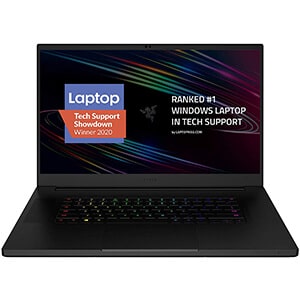
3. Razer Blade Pro 17
- Display: 17.3” 1080p
- CPU: Intel Core i7-10875H
- GPU: NVIDIA GeForce RTX 2080 Super Max-Q
- RAM: 16 GB
- Storage: 512GB SSD
Unlike most gaming laptops, the Razer Blade Pro 17 boasts great style and exceptional equipment.
The Pro 17 is one of Razer’s larger laptops and features a new, rectangular shape. However, the keyboard has the same customizable options (which is still a big attraction), so need to worry that they’ve up and changed that.
This laptop’s 17.3-inch display provides ample room that provides users a great experience. It is sharp, has touch options, and provides great resolution. With increased brightness and vivid details, this has to be one of the better options provided by Razer.
When it comes to performance, this laptop is somewhat of a jack of all trades. This multitasking device has scored well on many performance tests by reviewers, but mostly on uses other than gaming. For instance, it has a fantastic media transfer rate.
This laptop’s battery life is probably the only thing we don’t like about it – it lasts way less than average gaming laptops do. We expected a bit more given the increase in the time span between launches (namely, The Stealth, and Y740). However, while the battery life has not seen considerable improvement, the cooling system has been reformulated to retain significantly less heat, which is great.
All in all, the Razer Blade Pro is a great choice if you want a laptop that can perform well in both, professional and gaming areas. For the price point, however, we expected a few more features that would make this laptop worthwhile.
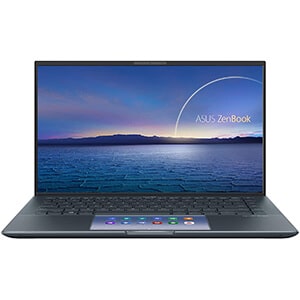
4. Asus ZenBook 14
- Display: 14” 1080p
- CPU: Intel Core i7-1165G7
- GPU: NVIDIA MX450
- RAM: 16 GB
- Storage: 512GB SSD
Until now, we’ve been discussing enormous, “larger than life” laptops. For those of you who prefer compact laptops, you might want to check out the Asus Zenbook 14.
There are two things to look forward to with this device: 1) Its price point. For all the things it has to offer, be it a good processor or commendable storage, the laptop is extremely affordable. 2) Its small size. It is remarkable how compact and light they made the laptop without discarding the many parts that provide exceptional quality.
This laptop has an elegant dark-blue design, and, as its name suggests, its display is extremely thin. The lid has a reflective shift to it, with the logo carved in a polished gold color. The device has also been tested in terms of military-grade durability, which is very impressive for a laptop of this budget range.
A few complaints – this machine lacks a Thunderbolt 3 port, which is a huge bummer. Also, the display is rather dim, however, the bezels (termed “NanoEdge”) provide a decent viewing experience.
Moving forward to the keyboard experience, the keys have been lifted a little in this model. This definitely makes it more user-friendly since the keys also appear to be sturdier. There is also a numeric keypad installed in the touchpad, which makes it very convenient to use.
The 14+ hour battery life is commendable, although it is receiving competition from other ultrabooks. Overall, it’s a good pick for those doing light work.
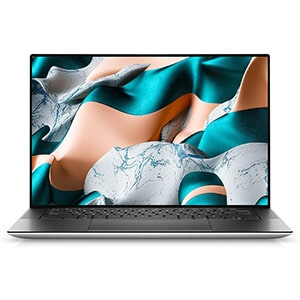
5. Dell XPS 15
- Display: 15.6” FHD+
- CPU: Intel Core i7-10750H
- GPU: NVIDIA GeForce GTX 1650 Ti
- RAM: 16 GB
- Storage: 512GB SSD
Dell XPS 15 laptops hardly have any flaws. Packed with exceptional performative elements and featuring a great design, this is one of the best of its kind currently on the market.
There are different configurations of this device available in the market, so the parts and prices vary accordingly. Considering the different prices, the assignment of elements such as processors, display, graphics, etc. is satisfactory.
Its design is as sleek as most preceding XPS laptops, with a keyboard and touchpad of modest size. The power button also reads fingerprints, which is an added benefit. The bezels in this model are so thin that they are almost indistinguishable, and the placement of the webcam is in the topmost bezel.
The XPS 15 is the first Dell laptop to have OLED technology included in its display. The viewing experience is great and captures even the smallest details present in an image on the screen. The capable touch screen is durable and has other accessories that make it easy to use.
This machine scored well in every performance test. From the storage test to the data transfer test, the laptop demonstrated outstanding performance. Its transcoding speed, especially, proved to be faster than the MacBook Pro.
The one issue this laptop has is its battery life, which is just above 8 hours on battery tests and is pretty unsatisfactory. However, for everything it has to offer, users might let this one thing slide. All things considered; this is one of the best laptops for data science.

6. Apple MacBook Pro M1
- Display: 13.3” Retina display
- CPU: Apple M1 Chip
- GPU: 8-core GPU
- RAM: 8 GB
- Storage: 512GB SSD
With the 13-inch MacBook Pro, Apple has made some serious amendments to its previous model, which consists of the inclusion of the new Apple M1 chip.
The new MacBook Pro’s design has not changed much. The color is the same space gray; there isn’t much change in dimensions either. The one good thing about its built is how lightweight it is. Definitely fit for portability, even for a pro laptop.
Another relief is that Apple has changed the keyboard from the disputed “Butterfly Switch” to the “Magic Keyboard” used initially in its iPads.
The presence of the Touch Bar brings us great joy, and the Escape Key has been made separate as well. The screen remains the same as the previous version, but we wish Apply included the thin bezels introduced in the 16-inch MacBook Pro.
This laptop’s performance is now admirable, as shown by the chrome tab test results. This improvement is the result of the new silicon chip that offers faster RAM and better graphics.
It is a fact that the battery life of MacBooks has essentially been better than their Windows contenders, and the same goes for the 13-inch MacBook Pro. Not only does it have a good battery life; it retains the battery life in an excellent manner.
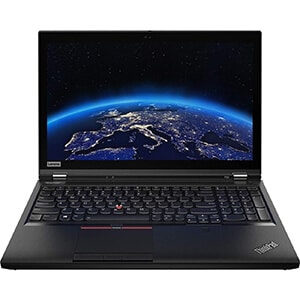
7. Lenovo ThinkPad P53
- Display: 15.6” 1080p
- CPU: Intel Core i7-9750H
- GPU: NVIDIA Quadro T1000
- RAM: 32 GB
- Storage: 1TB SSD
If we could use one word to describe the Lenovo ThinkPad P53, it would be “Powerhouse.” This portable workstation manages to be energy-efficient despite carrying out a substantial amount of workflow. Naturally, remarkable capacity comes at a remarkable price, so this laptop is pretty expensive.
Apple and other companies might be trying to make their devices thinner and more compact, but not Lenovo. The ThinkPad P53 weighs 5.5 pounds and consists of thick bezels. It is no surprise that this laptop has aced durability tests.
As for connectivity ports, there are plenty of them. There are two USB 3.1 Type-A ports, a USB 3.1 Type-C port, two Thunderbolt 3 ports, an SD card, and SC slots. Also, with Windows Hello, you get a camera with facial recognition and a fingerprint reader. Can you say security? (The camera itself is a little lackluster, as it produces low-quality images even in bright light, but it’s not a deal-breaker.)
This model, too, boasts Lenovo’s famous keyboards, which provide a smooth user experience. Also, with its lively images, the FHD display offers a sophisticated viewing experience.
Other good stuff includes the aced storage and memory tests. The bad? Awful battery life. We didn’t expect tons of hours, but we expected a bit more if that makes any sense. Overall, it is a great choice for office workers or people for whom durability is an important factor.
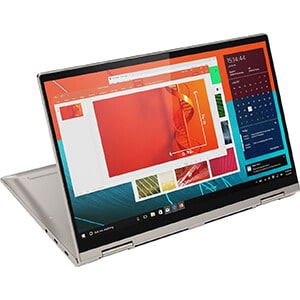
8. Lenovo – Yoga C740
- Display: 15.6” 1080p
- CPU: Intel Core i7-10510U
- GPU: Intel UHD Graphics
- RAM: 12 GB
- Storage: 512GB SSD
The Lenovo – Yoga C740 is yet another powerful laptop. With different energy-efficient specifications, this laptop also falls into the expensive category. The device features a chassis made of sturdy aluminum which makes it heavy, so it’s not a to-go kind of device.
As its name suggests, the Yoga C740 is flexible. It can rotate 360 degrees, which turns the laptop into a tablet mode. A downside of this feature is that the keys are not designed to withstand much pressure due to the absence of a lockdown system.
Its screen is touch-sensitive and comes with a complimentary Lenovo Active Pen 2. The screen is extremely reflective, and the colors are vibrant on display.
Alongside the good display and flexibility, the machine also boasts great speed. The graphics are supported by 2GB or 4GB RAM, and there are two processor options to go alone.
An interesting addition is the fingerprint reader. Honestly, the addition is not as interesting as the actual placement: the laptop’s wrist rest area. As for ports, you’ll find the usual suspects – nothing much is missing here.
As might be expected, a powerful device such as this one lacks battery life. Though it can be worked around a little by adjusting the brightness, the battery life, in general, is low.
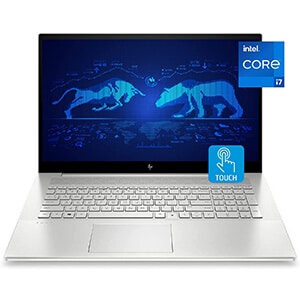
9. HP Envy 17t Touch
- Display: 17.3” 1080p
- CPU: Intel Core i7-1165G7
- GPU: Intel Iris Xe Graphics
- RAM: 32 GB
- Storage: 1TB SSD
Don’t want to move around your device much but still want it to be portable? The Envy 17t from HP has you covered. This stylish device is here to replace your desktops, folks!
The prime attraction of this laptop is definitely its gigantic 17.3-inch display. Such a big display is not usually found in common-use laptops.
The best part? The display is LED-lit, available in either full-HD or 4K resolutions. The resolution depends on the configuration. The only downside here is that the screen lacks OLED technology.
For a laptop this big, you’d expect it to be well built. Sadly, this is not the case. While the base does feel strong, it is not really well crafted.
The touchpad, especially, is such that users might face a lot of unwanted tapping. Other than this laptop’s weight, this is a huge concern. Also, there are some disappointments in the connectivity section, both, the Thunderbolt 3 port and the USB-C charger are absent.
We found this laptop’s design rather interesting. From flamboyant to sleek – we’ve seen it all, so we hardly notice simple yet elegant appearances these days. The Envy 17t is an exception. Its minimalist design has us floored. We can’t stop raving about how clear the laptop looks because all the buttons and lights are integrated with the keyboard.
Perhaps the most interesting feature of this laptop has to be its automated webcam privacy door. This feature is especially attractive now that we’re constantly using audio and video conferencing platforms.
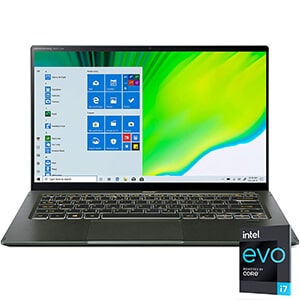
10. Acer Swift 5
- Display: 14” 1080p
- CPU: Intel Core i7-1165G7
- GPU: Intel Iris Xe Graphics
- RAM: 16 GB
- Storage: 1TB SSD
Returning with this recommendation for our portable laptop lovers- the Acer Swift is light, portable, and affordable!
The Acer Swift 4 is a regular laptop – simple in terms of design and features. Yet, it manages to look chic. There are different configurations for this laptop, but they all have the same, thin, lightweight design. Instead of being rectangular, the laptop is a bit tapered on the sides. Also, it’s a bit thick on the back end, where all the ports are.
There are many ports in this slim device, including the all-important Thunderbolt 3 and the USB Type-C port. However, there is no microSD card slot. The Swift 5 has a 1920 x 1080 full HD display which is not but it gets the job done.
This laptop’s performance is generally good. It scored average grades in the performance test; however, the data transfer rate was rather disappointing. Even with SSD, the time taken to transfer media files was unsatisfactory.
Getting back to what we like about this laptop – the keyboard is fairly good. It hardly makes noise, and the keys spring well. There’s also a Windows Hello fingerprint reader, which is always a nice addition.
The webcam is decent enough, however, the speakers could have a little more integrity to them. Also, the battery is just average; in most battery tests it lasted less than 8 hours.
Best Laptops for Data Science: Quick Answers
What type of laptop do I need for data science?
If you’re a data scientist, you need a laptop that has good connectivity, power, storage, and file transfer rate. You need something that does both, heavy-handed and light-handed tasks, swiftly.
You need to pay attention to the specifications, as every little detail will help you do your work better.
What is the best laptop for a data scientist?
The answer to this question depends on your preferences and what you, as a consumer, are looking for in laptops. Different devices have different specifications, all you need to do is pinpoint your requirement. Afterward, you can curate your own list.
We suggest you go through our reviews and find out which laptops work best for you. If you’re asking for recommendations, the HP Envy 17T is often recommended by users. The Lenovo ThinkPad P53 and the Apple MacBook Pro are also user favorites.
How much RAM do I need for data science?
RAM is an essential feature for data science-usable laptops. You typically need at least 8GB of RAM, however, 16GB will give you more speed.
If you’re coding, you’ll definitely need at least 16GB. Data analysis requires a lot of research, so choose wisely when it comes to RAM.
Is i5 enough for data science?
Intel processor i5 is regarded as adequate for a data scientist. Activities like coding, programming, etc., and working with larger data sets require a developed processor.
The i7 is also regarded as a great choice, but it can be expensive. If you cannot get an i7, try to make sure you find a laptop with the aforementioned i5 processor. Any version older than the i5 is not suitable for data science activities.
Which Operating System is the best for data science?
For a data scientist who is planning to buy a laptop, an operating system is as important as other factors such as storage, processor, etc. The two common choices are Mac OS and Windows. However, Linus is a good option. It is flexible and has different software choices. The best part? It’s free!
Final Words
So, this was our detailed review of the best laptops for data science. In this article, we tried to incorporate our top choices, a buying guide, and answers to some frequently asked questions.
At the end of the day, our best advice is for you to do your own research and find out what’s best for you! Thanks for reading!
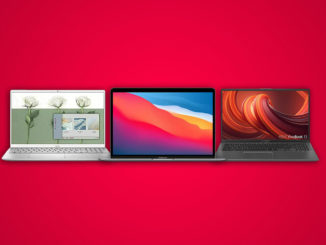

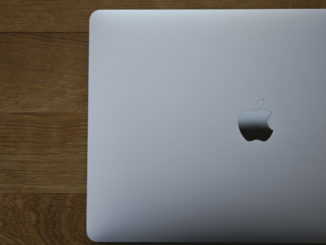

Be the first to comment